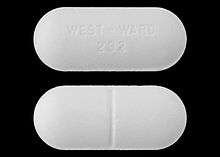Methocarbamol
Methocarbamol, sold under the brand name Robaxin among others is a medication used for short-term musculoskeletal pain.[2][3] It may be used together with rest and pain medication.[2] It is less preferred in low back pain.[2] It is not useful for cerebral palsy.[2] Effects generally begin within half an hour.[2] It is taken by mouth or injection into a vein.[2]
 | |
| Clinical data | |
|---|---|
| Trade names | Robaxin, others |
| AHFS/Drugs.com | Monograph |
| MedlinePlus | a682579 |
| Pregnancy category | |
| Routes of administration | By mouth, intravenous |
| ATC code | |
| Legal status | |
| Legal status | |
| Pharmacokinetic data | |
| Metabolism | Liver |
| Elimination half-life | 1.14–1.24 hours[1] |
| Identifiers | |
IUPAC name
| |
| CAS Number | |
| PubChem CID | |
| IUPHAR/BPS | |
| DrugBank | |
| ChemSpider | |
| UNII | |
| KEGG | |
| ChEBI | |
| ChEMBL | |
| CompTox Dashboard (EPA) | |
| ECHA InfoCard | 100.007.751 |
| Chemical and physical data | |
| Formula | C11H15NO5 |
| Molar mass | 241.241 g/mol g·mol−1 |
| 3D model (JSmol) | |
SMILES
| |
InChI
| |
| | |
Common side effect include sleepiness and dizziness.[2] Serious side effects may include anaphylaxis, confusion, liver problems, and seizures.[3] Use is not recommended in pregnancy and breastfeeding.[3] Methocarbamol is a centrally acting muscle relaxant.[3] How it works is unclear, but it does not appear to affect muscles directly.[2]
Methocarbamol was approved for medical use in the United States in 1957.[2] It is available as a generic medication.[3][2] A month supply in the UK costs the NHS about £12.72 as of 2019.[3] In the US the wholesale cost of this quantity is about US$6.50.[4] In 2016 it was the 187th most prescribed medication in the United States with more than 3 million prescriptions.[5]
Side-effects
Potential side-effects include: drowsiness, dizziness, clumsiness (ataxia), upset stomach, flushing, blurred vision, and fever. Both tachycardia (fast heart rate) and bradycardia (slow heart rate) have been reported;[6][7] these can be serious. Other serious side-effects include the development of a severe skin rash or itching, fainting, jaundice, persistent nausea/vomiting, stomach/abdominal pain, mental/mood changes, trouble urinating, and signs of infection. If taken in large amounts at once or more than directed or as prescribed, dysphoria or suicidal thoughts may occur.[8] Methocarbamol may cause urine to turn black, blue or green but the effect is harmless.[9]
Methocarbamol has a high therapeutic index, i.e., a wide range of safe and effective dosages. Consumer (OTC) doses are in the range 3–6 g per day,[10] while clinical doses can be as high as 24 g per day for severe conditions such as tetanus.[11]
Because of the potential for side-effects, this drug is considered to be a high-risk medication for the elderly.[12]
Abuse potential
Unlike other carbamates such as meprobamate and its prodrug carisoprodol, methocarbamol has greatly reduced abuse potential. Studies comparing it to the benzodiazepine lorazepam and the antihistamine diphenhydramine, along with placebo, find that methocarbamol produces increased "liking" responses and some sedative-like effects; however, at higher doses dysphoria is reported. It is considered to have an abuse profile similar to, but weaker than, lorazepam.[13]
Metabolism
Methocarbamol is the carbamate of guaifenesin, but does not produce guaifenesin as a metabolite, because the carbamate bond is not hydrolyzed metabolically; metabolism is by Phase I ring hydroxylation and O-demethylation, followed by Phase II conjugation. All the major metabolites are unhydrolyzed carbamates.[14][15]
Marketing

Methocarbamol without other ingredients is sold under the brand name Robaxin in the U.K., U.S. and Canada; it is marketed as Lumirelax in France, Ortoton in Germany and many other names worldwide.[16] In combination with other active ingredients it is sold under other names: with acetaminophen (Paracetamol), under trade names Robaxacet and Tylenol Body Pain Night; with ibuprofen as Robax Platinum; with acetylsalicylic acid as Robaxisal in the U.S. and Canada.[17][18] However, in Spain the tradename Robaxisal is used for the Paracetamol combination instead of Robaxacet. These combinations are also available from independent manufacturers under generic names.
See also
References
- Sica DA, Comstock TJ, Davis J, Manning L, Powell R, Melikian A, Wright G (1990). "Pharmacokinetics and protein binding of methocarbamol in renal insufficiency and normals". European Journal of Clinical Pharmacology. 39 (2): 193–4. doi:10.1007/BF00280060. PMID 2253675.
- "Methocarbamol Monograph for Professionals". Drugs.com. American Society of Health-System Pharmacists.
- British national formulary : BNF 76 (76 ed.). Pharmaceutical Press. 2018. pp. XXX. ISBN 9780857113382.
- "NADAC as of 2019-02-27". Centers for Medicare and Medicaid Services. Retrieved 3 March 2019.
- "The Top 300 of 2019". clincalc.com. Retrieved 22 December 2018.
- "methocarbamol" – via The Free Dictionary.
- "Methocarbamol Side Effects in Detail - Drugs.com". drugs.com.
- METHOCARBAMOL – ORAL (Robaxin) side effects, medical uses, and drug interactions. Medicinenet.com. Retrieved on 2011-11-09.
- Methocarbamol: MedlinePlus Drug Information. Nlm.nih.gov. Retrieved on 2011-11-09.
- "Robaxin (Methocarbamol): Side Effects, Interactions, Warning, Dosage & Uses". rxlist.com.
- "Methocarbamol Dosage Guide with Precautions - Drugs.com". drugs.com.
- See NCQA’s HEDIS Measure: Use of High Risk Medications in the Elderly Archived 2010-02-01 at the Wayback Machine
- Preston KL, Wolf B, Guarino JJ, Griffiths RR (1992). "Subjective and behavioral effects of diphenhydramine, lorazepam and methocarbamol: evaluation of abuse liability". Journal of Pharmacology and Experimental Therapeutics. 262 (2): 707–20. PMID 1501118.
- Methocarbamol. In: DRUGDEX System [intranet database]. Greenwood Village, Colorado: Thomson Healthcare; c1974–2009 [cited 2009 Feb 10].
- Bruce RB, Turnbull LB, Newman JH (Jan 1971). "Metabolism of methocarbamol in the rat, dog, and human". J Pharm Sci. 60 (1): 104–106. doi:10.1002/jps.2600600120. PMID 5548215.
- "Methocarbamol". Drugs.com. Retrieved 12 May 2018.
- "New Drugs and Indications Reviewed at the May 2003 DEC Meeting" (PDF). ESI Canada. Archived from the original (PDF) on 2011-07-10. Retrieved 2008-11-14.
- "Tylenol Body Pain Night Overview and Dosage". Tylenol Canada. Archived from the original (website) on 2012-03-31. Retrieved 2012-04-23.